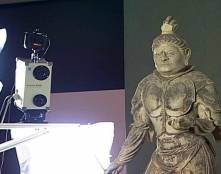Koumoku-Ten Clay Figure, National Treasure
The Koumoku-Ten clay figure is one of the series of Buddism clay figures "Shitennoh (Four Kings in Heaven)" made in 8th century. Its height is about 150cm and the name means that he can hear all sounds in the world. All these 'Shitennoh' images are National Treasures and normally kept in Kaidan-In, Toudaiji Tepmle. Because these ones are fragile (made of clay), it is very rare to be moved outside of Kaidan-In.On the June-July 2002, these figures are temporally moved to Nara National Museum for the purpose of the 1250th anniversary presentation of Toudaiji Temple. It was the first time in 17 years. During this presentation, we digitized this figure under the coorperation with Toudaiji Temple and Nara National Museum.
Scanning


[Left] Koumoku-Ten and Tamon-Ten clay figures
[Right] Scanning scene of Koumoku-Ten

Calibration of geometrical sensor and Image Sensor
Koumoku-Ten clay figure is still having the surface colors that were painted at the time of manufacture. For these sorts of cultural properties, we have to archive geometry information, texture information and the relation of them at the same time. For this purpose, we used two kinds of sensors : geometrical scanners (Minolta Vivid900 and Cyrax) and super fine digital camera (Nikon D1X). The numbers of acquired range and color images are :
| Cyrax 2400 (640000 points) | 7 scans |
| MINOLTA VIVID900 (300000 points) | 224 scans |
| NIKON D1X (2000 x 1800 pixels) | 224 shots |
Before the scanning, we have taken the range and geometriy images of the calibration box (left picture). According to these images, we can acquire the geometrical relations between geometrical sensor's coordinates and the image sensor's coordinates.
Result
Acquired range images ware aligned to the same co-ordinate. They ware merged
to from a complete model. The model was then manually refined. Left two
images are the geometrical models of this figure.
We have also developped the method to align the textures onto geometrical
model. Due to the calibration, we can acquire the relation parameters of
the range sensor and the image sensor. According to this parameter, we
can map the texture images acquired by the image sensor onto the final
geometrical model. Final texture-aligned computer graphics are showing
below:



Geometrical model of Koumoku-Ten (left), and texture-mapped model (right).

Synthesized results under various lighting conditions (Sunrise->Daytime->Sunset).
| Size (in VRML file) | 160,596KB |
| Polygons | 3,285,809 |